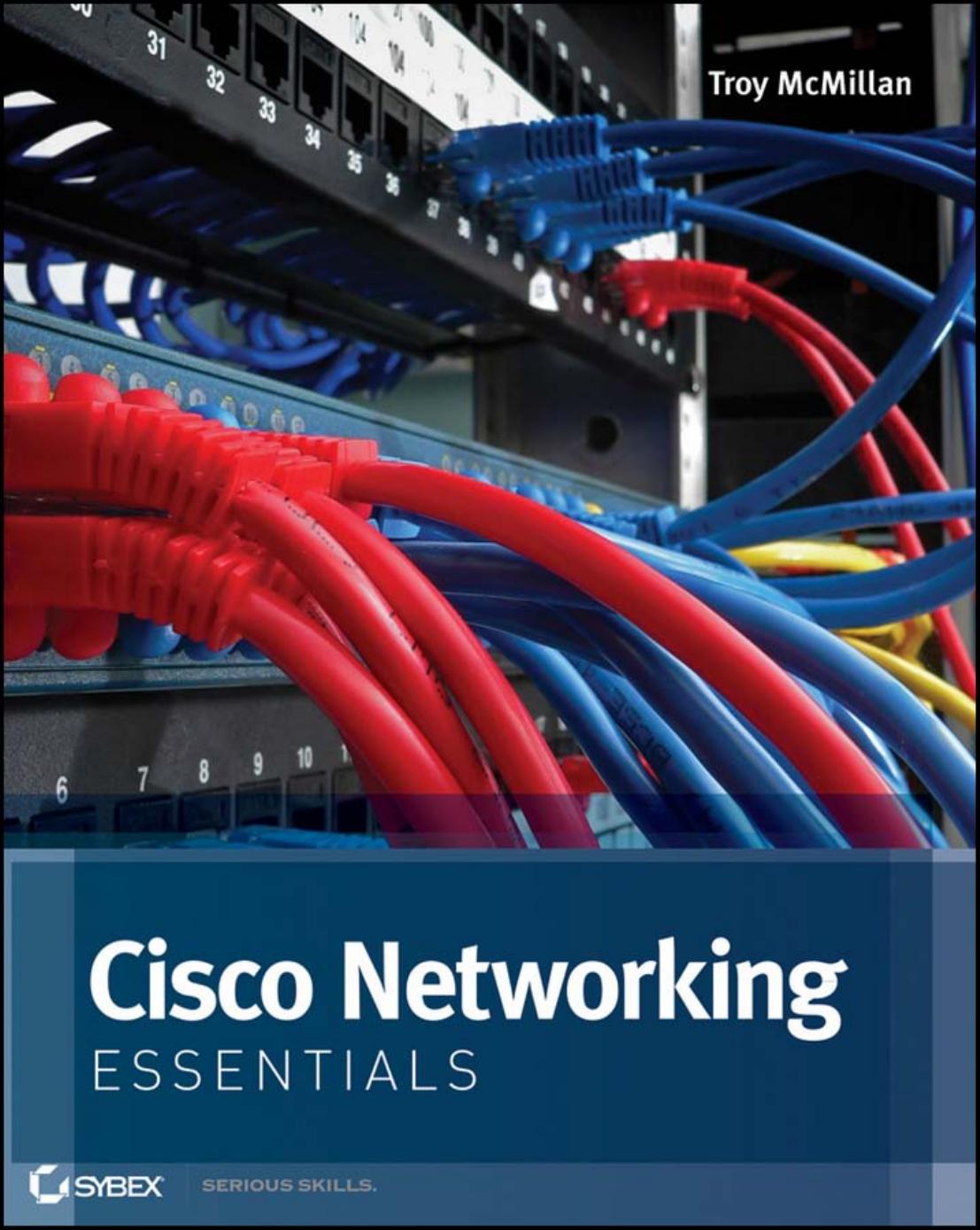Cisco Networking Essentials 1st Edition by Troy McMillan ISBN 1118097599 9781118097595
$70.00 Original price was: $70.00.$35.00Current price is: $35.00.
Instant download Cisco Networking Essentials after payment
Cisco Networking Essentials 1st Edition by Troy McMillan – Ebook PDF Instant Download/Delivery: 1118097599, 9781118097595
Full dowload Cisco Networking Essentials 1st Edition after payment

Product details:
As the world leader of networking products and services, Cisco products are constantly growing in demand. Yet, few books are aimed at those who are beginning a career in IT–until now. Cisco Networking Essentials provides a solid foundation on the Cisco networking products and services with thorough coverage of fundamental networking concepts. Author Troy McMillan applies his years of classroom instruction to effectively present high-level topics in easy-to-understand terms for beginners. With this indispensable full-color resource, you’ll quickly learn the concepts, processes, and skills that are essential to administer Cisco routers and switches.
- Begins with a clear breakdown of what you can expect to learn in each chapter, followed by a straightforward discussion of concepts on core topics
- Includes suggested labs and review questions at the conclusion of each chapter, which encourage you to reinforce and measure your understanding of the topics discussed
- Serves as an ideal starting point for learning Cisco networking products and services
If you are interested in a career in IT but have little or no knowledge of networking and are new to Cisco networking products, then this book is for you.
Cisco Networking Essentials 1st Table of contents:
Chapter 1 Networks
Describing Network Components
Defining the Benefits of Networks
Identifying the Requirements for a Network
Classifying Networks by Function
Understanding LANs
Understanding WANs
Defining Network Architectures
Understanding Peer-to-Peer Networks
Understanding Client-Server Networks
The Essentials and Beyond
Chapter 2 The OSI Model
Using Reference Models
Understanding the Benefits of Reference
Exploring Reference Model Examples
Introducing the Layers of the OSI Model
Understanding the Application Layer
Understanding the Presentation Layer
Understanding the Session Layer
Understanding the Transport Layer
Understanding the Network Layer
Understanding the Data-Link Layer
Understanding the Physical Layer
Describing the OSI Encapsulation Process
Identifying the Process on the Source Device
Identifying the Process on the Destination Device
The Essentials and Beyond
Chapter 3 TCP/IP
Understanding the TCP/IP Model
Exploring the Four Layers
Comparing the OSI and TCP/IP Models
Describing the TCP/IP Encapsulation Process
Understanding Data and PDUs
Describing the Contents of Data
Describing the Contents of Segments
Describing the Contents of Packets
Describing the Contents of Frames
Understanding the Conversion to Bits
Describing the Functions at the Transport Layer
Understanding TCP
Understanding UDP
Describing the Functions at the Internet Layer
Defining Logical Addressing
Performing Routing
Accomplishing Packet Forwarding
Describing the Functions of ARP
Illustrating the ARP Broadcast
Describing the Logic of MAC-to-IP-Address Conversion
The Essentials and Beyond
Chapter 4 Protocols
Understanding the Function of Protocols
Defining Routed Protocols
Defining Routing Protocols
Exploring Application Layer Protocols
Describing FTP
Describing TFTP
Describing SMTP
Describing DNS
Describing SNMP
Exploring Transport Layer Protocols
Reviewing TCP
Reviewing UDP
Exploring Internet Layer Protocols
Describing IP
Describing ARP
Describing ICMP
Describing IGMP
Exploring Network Access Layer Protocols
Defining Network Access Layer Protocols on the LAN
Defining Network Access Layer Protocols on the WAN
The Essentials and Beyond
Chapter 5 Physical and Logical Topologies
Designing the Physical Topology
Implementing a Bus Topology
Implementing a Ring Topology
Implementing a Star Topology
Implementing a Mesh Topology
Implementing a Hybrid Topology
Implementing a Point-to-Point Topology
Implementing a Point-to-Multipoint Topology
Designing the Logical Topology
Understanding the Token Ring Topology
Understanding the FDDI Ring Topology
Understanding the Star Topology
The Essentials and Beyond
Chapter 6 Numbering Systems
Exploring Binary Numbering
Understanding the Base-2 Numbering System
Understanding the Relationship between Binary and Computers
Exploring Hexadecimal Numbering
Understanding the Base-16 Numbering System
Identifying MAC Addresses
Applying Conversions
Decimal-to-Binary Conversion
Hex-to-Decimal Conversion
Binary-to-Hex Conversion
The Essentials and Beyond
Chapter 7 Classful IP Addressing
Describing the Function of IP Addresses
Identification
Segmentation
Identifying IP Address Types
Defining IP Address Classes
Identifying Network and Host Addresses
Describing Private IP Addresses and NAT
Utilizing Diagnostic Tools
Executing the ipconfig Command
Executing the ping Command
Executing the arp Command
Executing the traceroute Command
Understanding DHCP
Operations
Cisco DHCP
Introducing IPv6
IPv6 Address Format
IPv6 Address Types
Special IPv6 Addresses
The Essentials and Beyond
Chapter 8 Classless IP Addressing
Understanding the Limitations of Classful Networking
Exhaustion of the Class B Network Address Space
Unmanageable Routing Tables
Exhaustion of the 32-Bit IPv4 Address Space
Understanding the Benefits of Subnetting
Identifying Sources of Network Congestion
Deploying Subnetting as a Segmentation Tool
Describing the Components of CIDR
Introducing Classless Subnetting
Designing and Implementing CIDR
Understanding VLSM
Summarization
The Essentials and Beyond
Chapter 9 Media
Selecting the Proper Media Type
Bandwidth
Security
Convenience
Cost
Understanding Cabling
Describing Cable Behavior and Characteristics
Describing Physical Implementations
Choosing the Correct Wiring Standard
Describing Wireless Standards
Identifying Standards Bodies
Understanding 802.11 Amendments
Understanding Wireless LAN Components and Terminology
Describing CSMA/CA Operation
The Essentials and Beyond
Chapter 10 Network Devices
Describing Device Functions
Understanding Repeaters
Understanding Hubs
Understanding Bridges
Understanding Switches
Understanding Routers
Understanding Wireless Access Points and Wireless Routers
Understanding Device Placement Principles
Defining Broadcast Domains
Defining Collision Domains
Understanding the Cisco Three-Layer Model
The Essentials and Beyond
Chapter 11 LAN Operations
Understanding the Routing Process
Describing Routing Tables
Understanding Population Methods
Understanding Administrative Distance
Using Routing Protocols
Describing the Switching Process
Reviewing MAC and IP Addresses
Reviewing Contention Methods
Describing MAC Address Tables
Understanding Frame Forwarding
Describing End-to-End Communications
Understanding the Local LAN Process
Understanding the Remote Communication Process
The Essentials and Beyond
Chapter 12 Managing the Cisco IOS
Describing Components
Defining the Contents of RAM
Defining the Contents of NVRAM
Defining the Contents of Flash
Defining the Contents of ROM
Describing IOS Navigation
Connecting to the Device
Accessing User, Privileged, and Global Configuration Modes
Understanding and Managing the Boot Process
Understanding the Boot Process
Managing the IOS
Understanding Configuration Files
Managing the Configuration Register
The Essentials and Beyond
Chapter 13 Configuring Routers
Cabling the Router
Cabling Router to Router
Cabling Router to Switch
Cabling PC to Router
Cabling Router to CSU/DSU
Creating a Console Session
Connecting with the Console Cable
Connecting Through the USB Port
Connecting Through Telnet
Handling Initial Setup
Configuring Passwords
Interpreting Prompts
Configuring Privileged (Enable) Passwords
Configuring Enable Secret Passwords
Configuring Line Passwords
Configuring Interfaces
Accessing Interface Mode
Assigning an IP Address
Enabling the Interface
Verifying the Interface
Configuring a Router as a DHCP Server
Configuring WAN Interfaces
Saving Configuration Changes
The Essentials and Beyond
Chapter 14 Configuring Switches
Cabling the Switch
Cabling Switch to Switch
Cabling Router to Switch
Cabling Hosts to Switch
Creating a Session with the Switch
Creating a Session with the Console Cable
Creating a Session Through Telnet
Configuring Passwords
Configuring Privileged (Enable) Passwords
Configuring Enable Secret Passwords
Configuring Line Passwords
Using the service password-encryption Command
Configuring Interfaces
Accessing Switchports and Using Switchport Mode
Enabling the Port
Verifying the Port
Understanding Advanced Switch Functions
Understanding VLANs
Configuring VLANs
Assigning Ports to VLANs
Understanding Trunk Ports
Configuring Trunk Links
Describing STP
Understanding Port Security
Limiting MAC Addresses
Implementing Sticky Mac
The Essentials and Beyond
Chapter 15 Configuring Static Routing
Populating the Routing Table
Using the ip route Command
Verifying the Route Table
Configuring Inter-VLAN Routing
Creating a Trunk Link with Encapsulation
Creating and Configuring Subinterfaces
Troubleshooting VLANs
Troubleshooting Trunk Links
Troubleshooting Inter-VLAN Routing
The Essentials and Beyond
Chapter 16 Configuring Dynamic Routing
Understanding Routing Protocols
Exploring RIP
Exploring EIGRP
Exploring OSPF
Configuring Routing Protocols
Enabling a Routing Protocol and Accessing Router Mode
Defining the Interfaces on Which the Protocol Is Operational
Verifying the Routing Table
The Essentials and Beyond
Chapter 17 Device Security
Understanding Access Lists
Understanding Standard Access Lists
Understanding Extended Access Lists
Configuring Numbered Access Lists
Configuring Named Access Lists
Editing Access Lists Using Sequence Numbers
Understanding Network Address Translation (NAT)
Implementing Static NAT, Dynamic NAT, and PAT
Configuring a Switch or Router as an NTP Client or Server
Implementing and Requiring SSH
Limiting Remote Access with ACLs
The Essentials and Beyond


